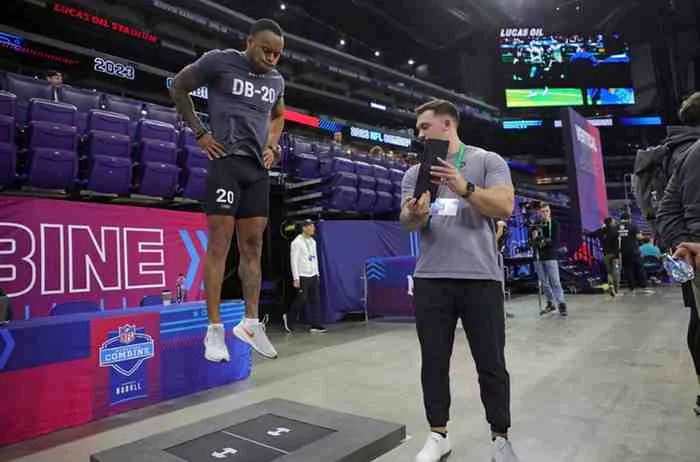[mashshare]

I’m addicted to speed. I love the transmutation of slow to fast. This is why I am a track coach and a speed coach.
I have timed over 150 thousand 40’s since I began data-based speed training in 1998. Run fast to get fast. You don’t get fast by running slow. You don’t get fast in the weight room. You don’t get fast by running with a parachute on your back. You don’t get fast by running up or down hills or pushing sleds or running stairs or wearing ankle weights. Run fast to get fast. It’s all so simple.
Before you get too excited, remember the immortal words of jazz musician Thelonius Monk, “Hey man, simple ain’t easy.” In addition, this transformation will not happen overnight.
I’m excited to write this article because I’m going to use one of my track athletes to tell the story. I met Alex Ruscitti in June of 2010 following his 7th grade school year. Alex was an average white kid of average height and weight, just another kid attending Speed Camp. His best time of 5.38 (and 1.30 in the 10-meter fly) would indicate that he had some running talent but was not one of those “gifts from the gods”. At the same camp, my top varsity sprinter, Derick Suss ran 4.41 in 40 and 0.99 in the 10-meter fly.
Fast forward to 2014. 6’0″, 170-pound Alex Ruscitti has completed his junior year and is back at speed camp for the 5th consecutive year. Alex ran 4.46 in the 40 and 1.05 in the 10m fly. His personal records are 4.37 and 1.04. Alex was not born genetically coded for track & field success. Neither parent played a varsity sport in high school. Alex’s strongest attributes are his work ethic and his intelligence (33 ACT).
Slow to fast. 5.38 to 4.37 makes me feel all tingly as a speed coach. But wait … it took FOUR FREAKIN’ YEARS. “Hey man, simple ain’t easy.”
I get so sick of those snake oil salesmen who advertise quick fixes to improve speed. Speed training is a process. Speed grows like a tree. I am a teacher and a coach. I don’t sell video. I don’t sell gadgets. I have no reason to sell you crap that doesn’t work.
“Hey, can you work with my son? He wants to run a good 40 at a combine next week.” … “Why didn’t he go out for track?” … “He needed to get big.”
“Hey, can you work with my daughter? She is the slowest girl on her soccer team.” … “Yeah, sure. Speed Camp starts next week.” … “Well, she doesn’t have time for that. Can you just give me a few drills?.”
Everyone wants instant results. Everyone wants the answers before they take the test. Everyone wants a short cut. If you fit in this group, please stop reading now. Go back to your quick-fix life. Take a pill. Buy a lottery ticket.
If you want to make kids fast, read on.
As track coaches, we love those “gifts from the gods”. We love panning for gold and finding that once-in-a-lifetime sprinter. This year I have timed incoming freshmen at Plainfield North High School who have run 4.49, 4.62, 4.65, and 4.69 in the 40. Those guys are not “gifts from the gods” but hey, my freshmen football team may not lose.
Once in a while you get a sprinter who is genetically destined for greatness. If you are a track coach or a speed coach and you haven’t read “The Sports Gene” by David Epstein, you are a pretender. Read. Anyway, its obvious to me that we don’t “plant beans and grow corn”. The elite sprinters are truly FOUND and not created.
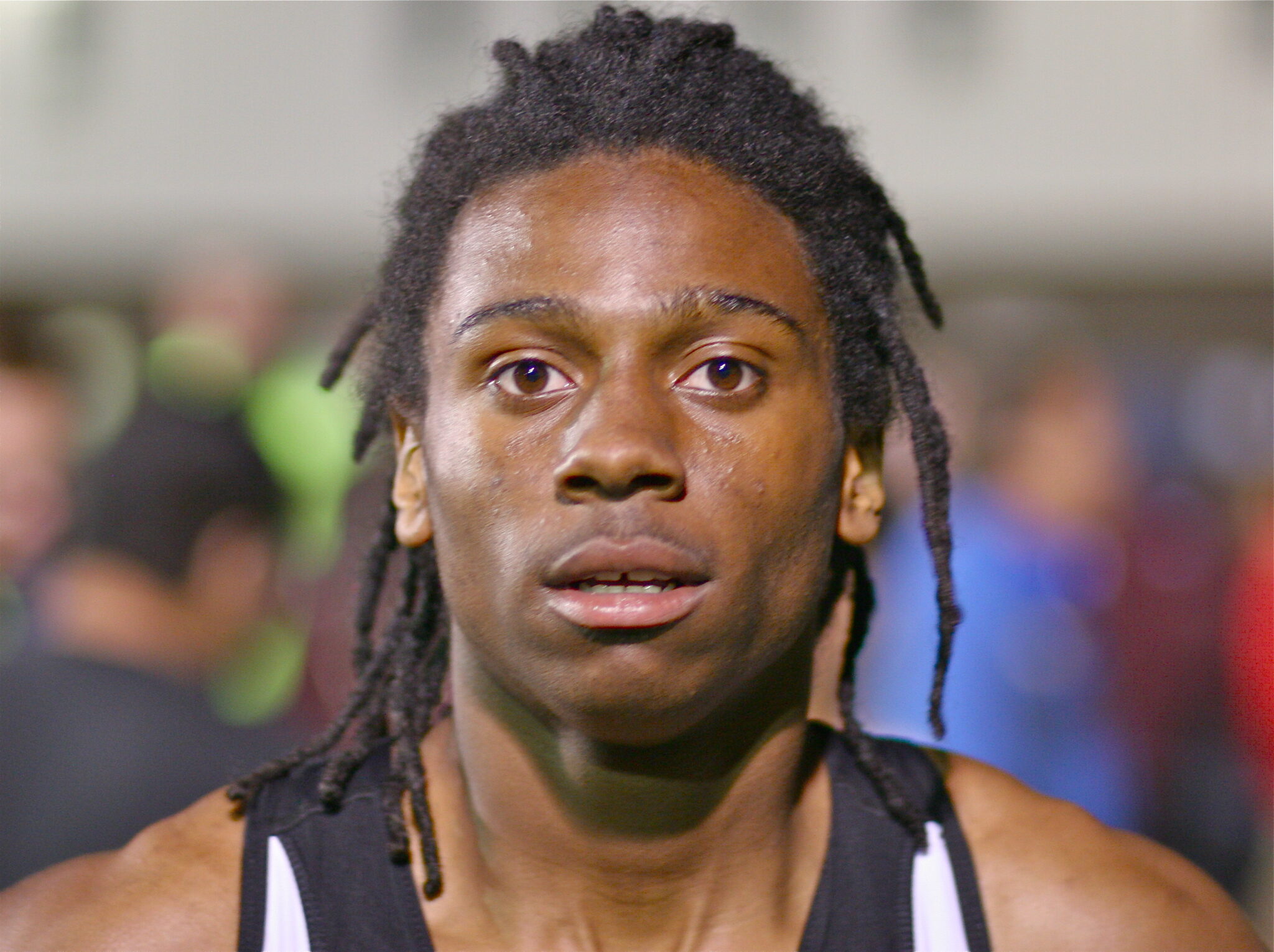
If you want to get my take on coaching guys like Juawan Treadwell, you will have to wait till my next blog, “Coaching Elite Sprinters.”
It’s strange but when you go to a clinic, you see presentations by coaches who were blessed with a freaky sprinter or two. We all want to know how coaches create such an athlete. The presenter hides behind a sophisticated and complex PowerPoint that overwhelms the crowd and makes everyone feel inferior. Remember, the presenter is the beneficiary of genetic talent and deep down, he knows it. It’s like shuffling a deck of cards and playing solitaire. Winning and losing is predetermined after the shuffling. College coaches don’t create speed, they find speed.
Take the training methods of the Jamaicans with a grain of salt. Most of us are coaching normal everyday kids, not the one-in-a-million sprinter. Most of us are coaching kids like Alex Ruscitti. I’m going to teach you the training methods used in Plainfield, Illinois, not Kingston, Jamaica. My focus is the speed transformation of a generic white guy, not the freaky outliers of the sprint world. Have you read “Outliers” by Malcom Gladwell? Have you read “The Talent Code” by Daniel Coyle. Read.
So here are the 3 simple (but not easy) ways to transform slow to fast. The entire discussion will focus on getting fast in the 40 yard dash. The NFL draft takes the best 500 college football players in the nation and puts then through several tests. When the day is done, the most important quantifiers are height, weight, and 40-speed. Even offensive linemen who run fast in the 40 are prized possessions. The top 3 offensive tackles taken in the NFL draft averaged 4.95 in the 40 despite averaging 6’6″ and 316 pounds. Check out this incredible video of 6’7″, 309 pound Taylor Lewan from Michigan running the 40. Lewan was the fastest offensive tackle in the draft.
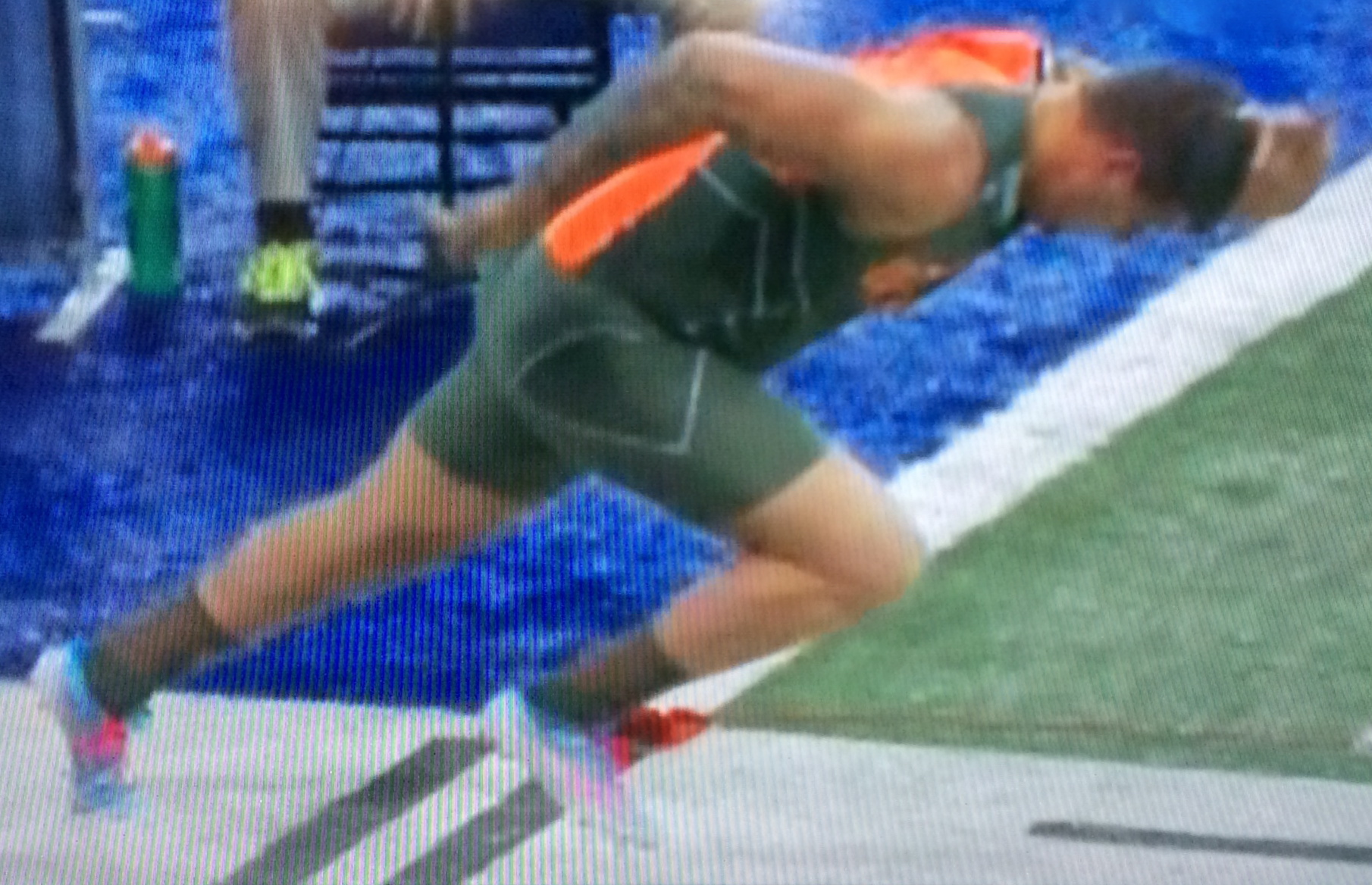
My off-season training relies on 40 training because the 40 requires work on the only two things that matter in sprinting, the DRIVE PHASE and MAX SPEED. In addition, my focus on 40 yards keeps me in good standing with football players who will hopefully make up the majority of my track team in the spring. The 10-meter fly is a better predictor of sprint success but my focus here will be the 40.
One more thing. I need to explain my data. I hand-time 40s. I have the technology for automated timing but I have 15 years of data that will become obsolete when I switch. The time I record is the average of the sprinter’s best two times of the day. We always run in spikes. All winter training is done on a rock-hard 180-meter indoor track and we wear spikes. If you are timing 40s with an automated system in your hallways without spikes, your times will be much slower than mine. You can’t compare apples to oranges. My 10-meter fly times are automated using the Summit Timing System. I’m in the process of switching over to Freelap. I’m seriously considering taking the plunge and timing everything with Freelap starting next winter. Freelap is one-tenth the size of Summit, wireless, weatherproof, and windproof. In addition, I will be able to process hundreds of sprints in half the time. I’m going to sell my Summit. Everyone must evolve.

Running Mechanics
Damn, it’s easy to get lost in the complexities here. For example, the single most important characteristic of speed is vertical force. All world-class sprinters have ground contact times of close to 0.08 seconds … eight hundredths of a second. It takes an enormous colossal force to achieve ground contact times that are measured in hundredths of a second. But even the experts can be mystified by vertical force. “Put simply, fast people hit the ground more forcefully than slow people, relative to their body weight. But we know very little about what contributes to that force, and we are terrible at predicting it based on a runner’s physique or movements.” -Dr. Peter Weyland If you want to read more about vertical force, see a blog I wrote a few months ago, Vertical Force = The Holy Grail.
Let’s cut through sophisticated and complex science. Let’s skip the PowerPoint presentations from people who make a living by keeping things complicated. Let’s learn the simplicity of speed mechanics. As Oprah would ask, “What do you know for sure?”
There are two phases to sprinting … the drive phase and max speed. The 40-yard dash requires both. Don’t argue with me that the entire 40 is a drive phase. If it was, max speed would be a poor indicator of 40-speed. The opposite is true. The 10-meter fly is the best predictor of 40-speed. The techniques of the drive phase are important but pure speed is still the key.
My son, Alec Holler, coaches at Edwardsville High School. Alec is my proofreader. When he read the unpublished version of my blog, this was his comment: “I think you emphasize max velocity too much. It’s all about the drive phase and start to me. Yes you have to have the max velocity to run elite 40 times, but the start is one of the rare cases that a coach can make a difference in track. You need to video, take pics, and give tons of feedback. You need to have classroom sessions and pound drive phase into their heads all winter. Acceleration should be the focus of winter workouts.” Powerful statement. I agree 100% percent. Drive phase is mostly coaching. Speed is mostly talent.
The drive phase is hard to teach. Young runners want to stand up straight, spin their wheels, and start running. If they start in a three-point or four-point stance, they still get to an upright position as soon as possible and start spinning those wheels. Anyone who has taught sprinting knows exactly what I’m talking about.
The fundamentals of the drive phase will translate to block starts in track. The drive phase starts at velocity zero. The fundamentals do not change if you are leaning into the start from a 2-point stance, in a football-like 3-point stance, or in a 4-point track & field block start.
The bullet points of the drive phase:
- Push with the front foot, pull the back foot, dragging the toe
- Imagine the feet pushing the hips forward
- The feet stay behind the hips, the hips stay behind the shoulders (triple extension)
- Ground contact times are much longer in the ground phase (Ben Johnson, when he ran 9.83 in Seoul, had average ground contact time of 0.115 in the first 10 meters, 0.80 at top speed after 40 meters)

Verbal cues of the drive phase
- “Push & Pull”
- “Drag Your Toe”
- “See the Track”
- “Big & Strong”
- “Don’t Spin Your Wheels”
- “Split & Rip”
- “Push Push Push”
- “Run in a Lane Inside of a Lane”
- “Fewest Steps Wins”
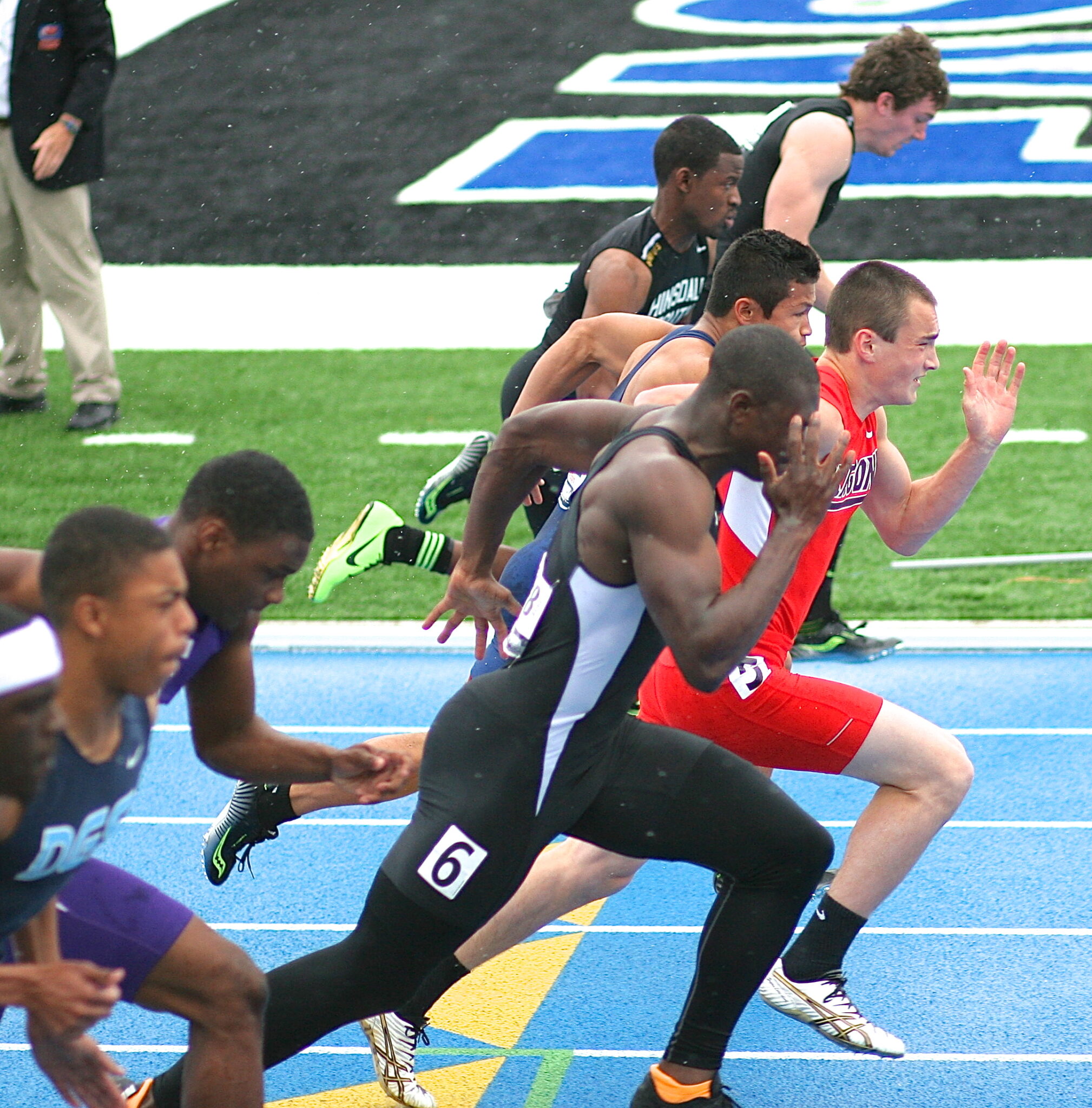
Many athletes will try to stay in the drive phase too long. Their body is upright but they keep their chin down trying to see the track. The drive phase is over when the shoulders are on top of the hips. You can’t extend your drive phase by running tall and looking down at the track. Silly. If your drive phase is over after five steps, get tall and sprint.
The drive phase may last between 5 and 35 yards based on the skill and speed of the runner. A little kid may have a two step drive phase. World class sprinters may not “get tall” until they are over 30 meters into their 100 meter dash. 30 meters is 33 yards. I’ve never coached a high school sprinter who could maintain a drive phase for 30 meters. Sorry for mixing yards and meters here.
The super-simplified boiled-down bullet points of Max Speed:
- Get tall … 5’10” sprinters look like they are 6’0″ when at max speed
- Legs … “get big in the front, short in the back”
- Arms … “hands must cross the hips” … must see lots of day light between butt and back hand
- Think “big & strong”, not short & quick … don’t spin your wheels
- Bounce off the ground … never “grab the track and throw is behind you”
If you want an expanded version of speed training, you can go to a blog I wrote last year, The Nuts and Bolts of Speed Training.
I teach mechanics through speed drills. I also take pictures. We also video with an iPad.
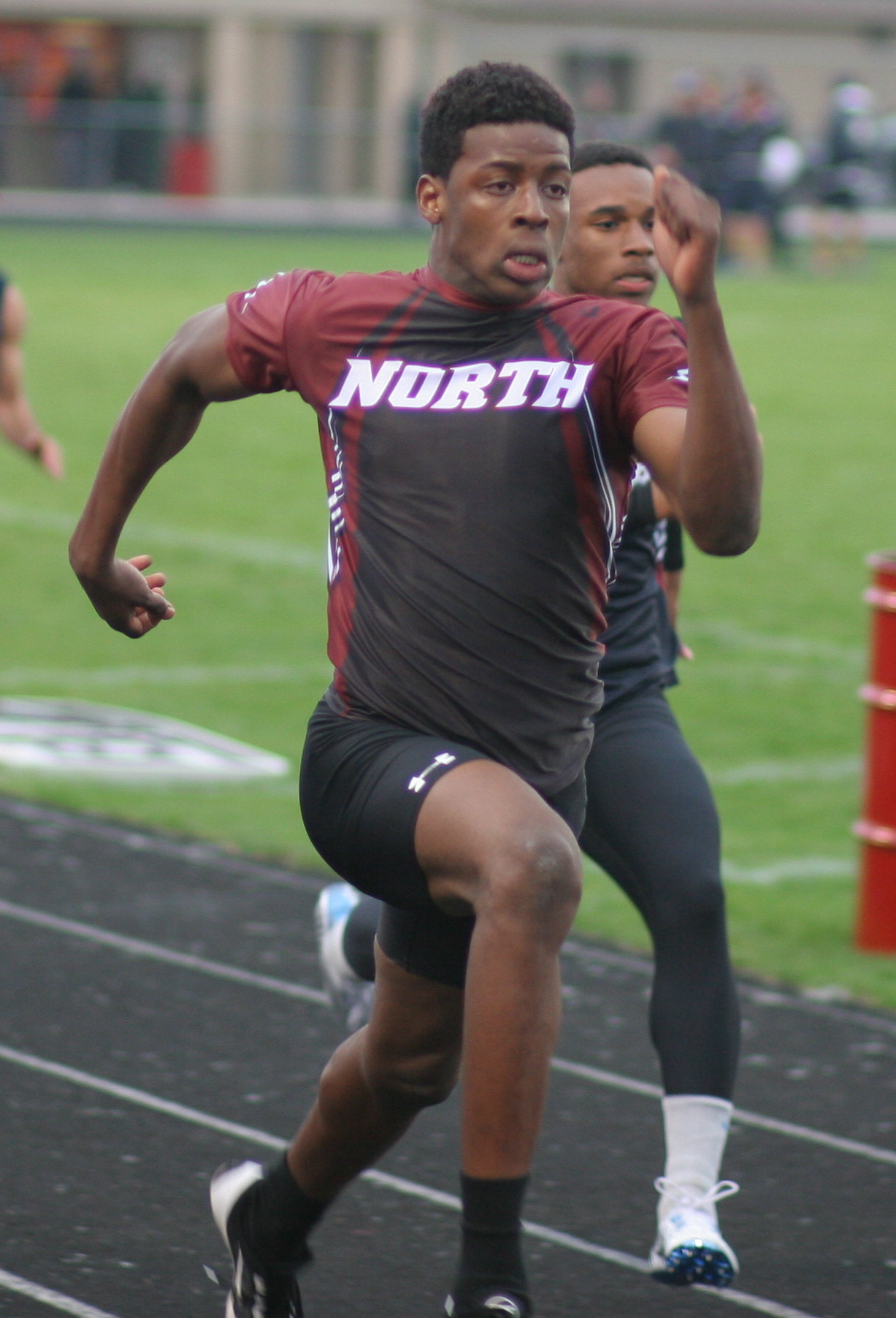
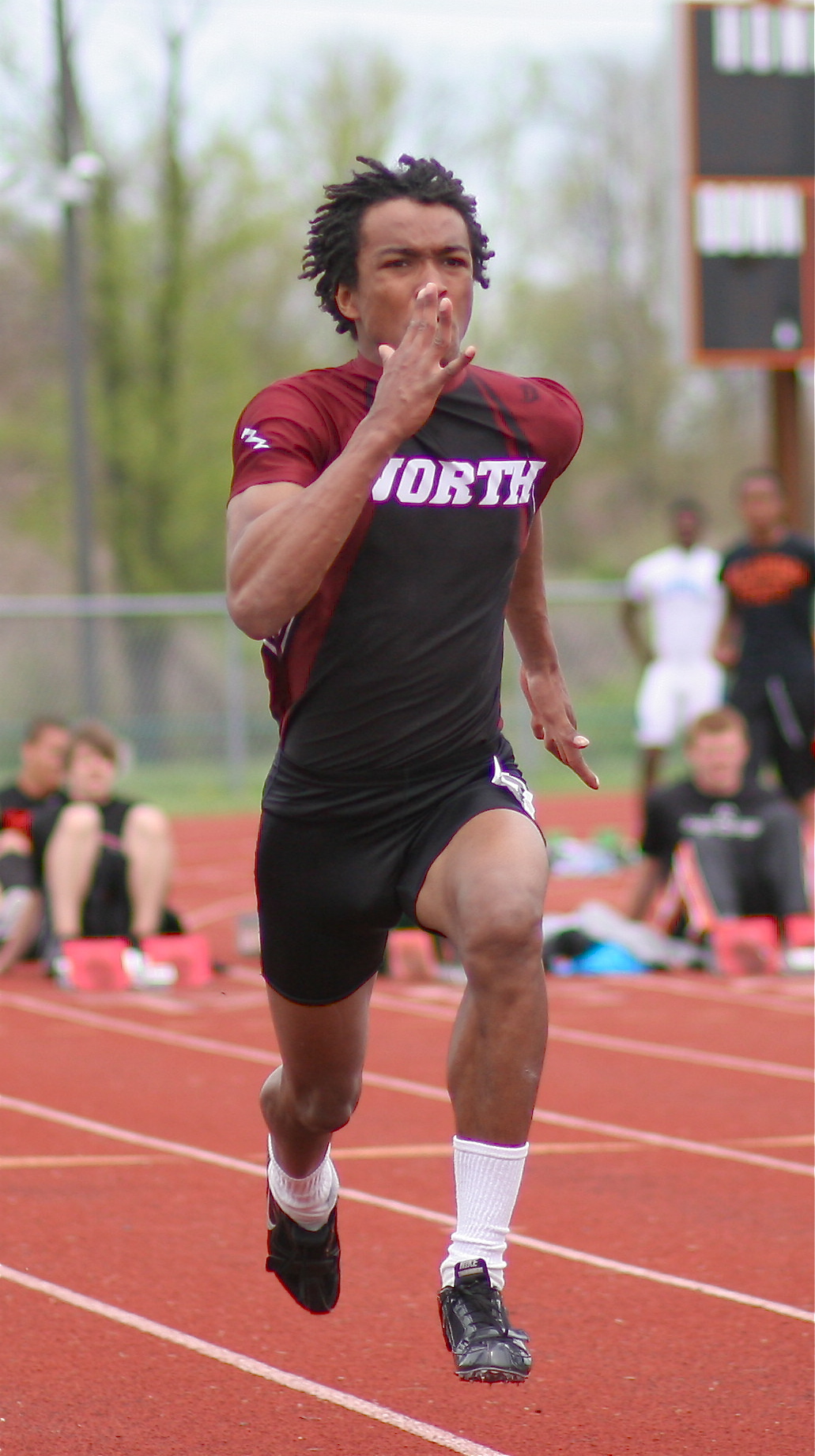
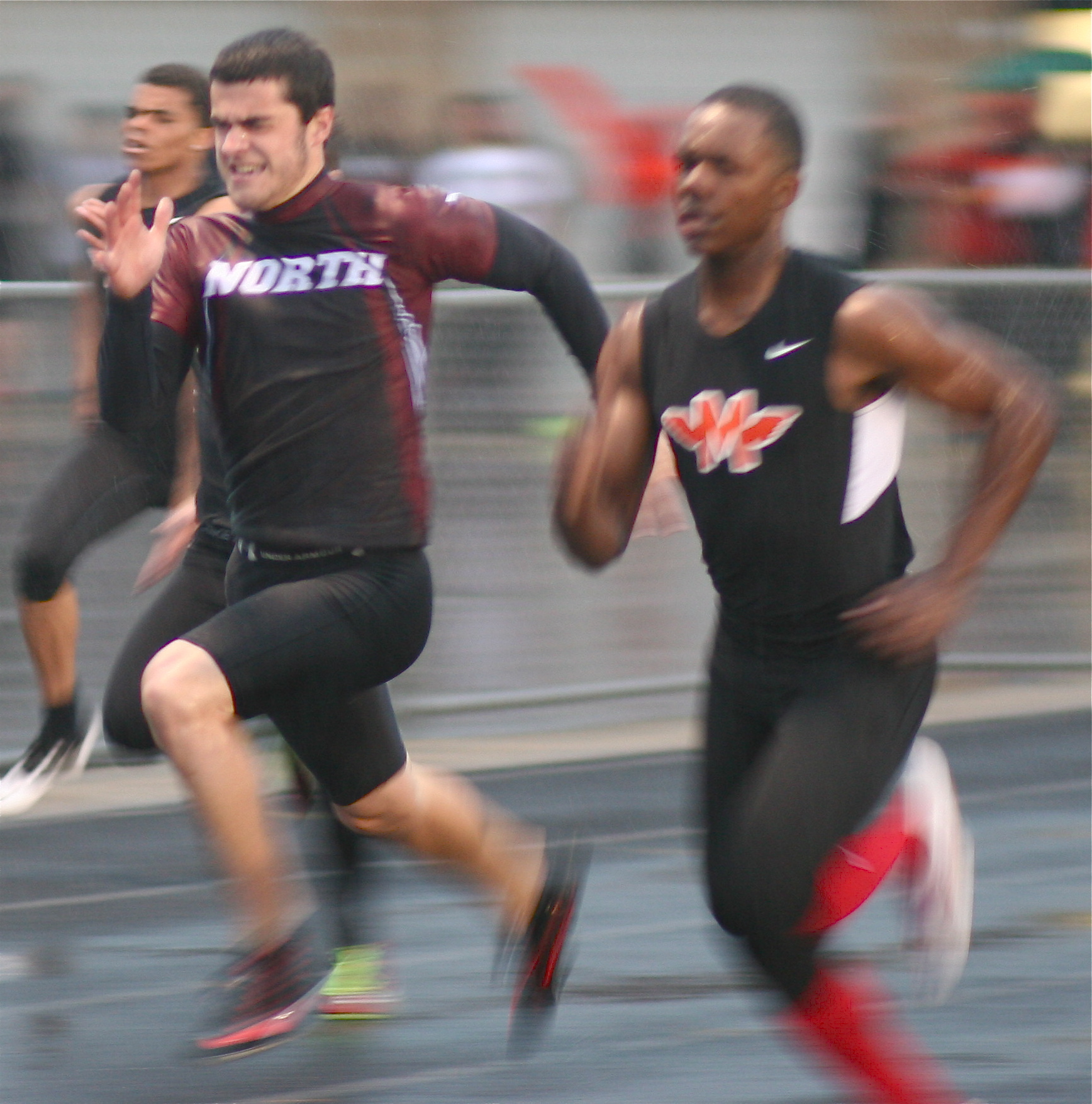
As I said, I teach and train the “run tall” and “get big in the front” and “hands cross the hips” by using speed drills.
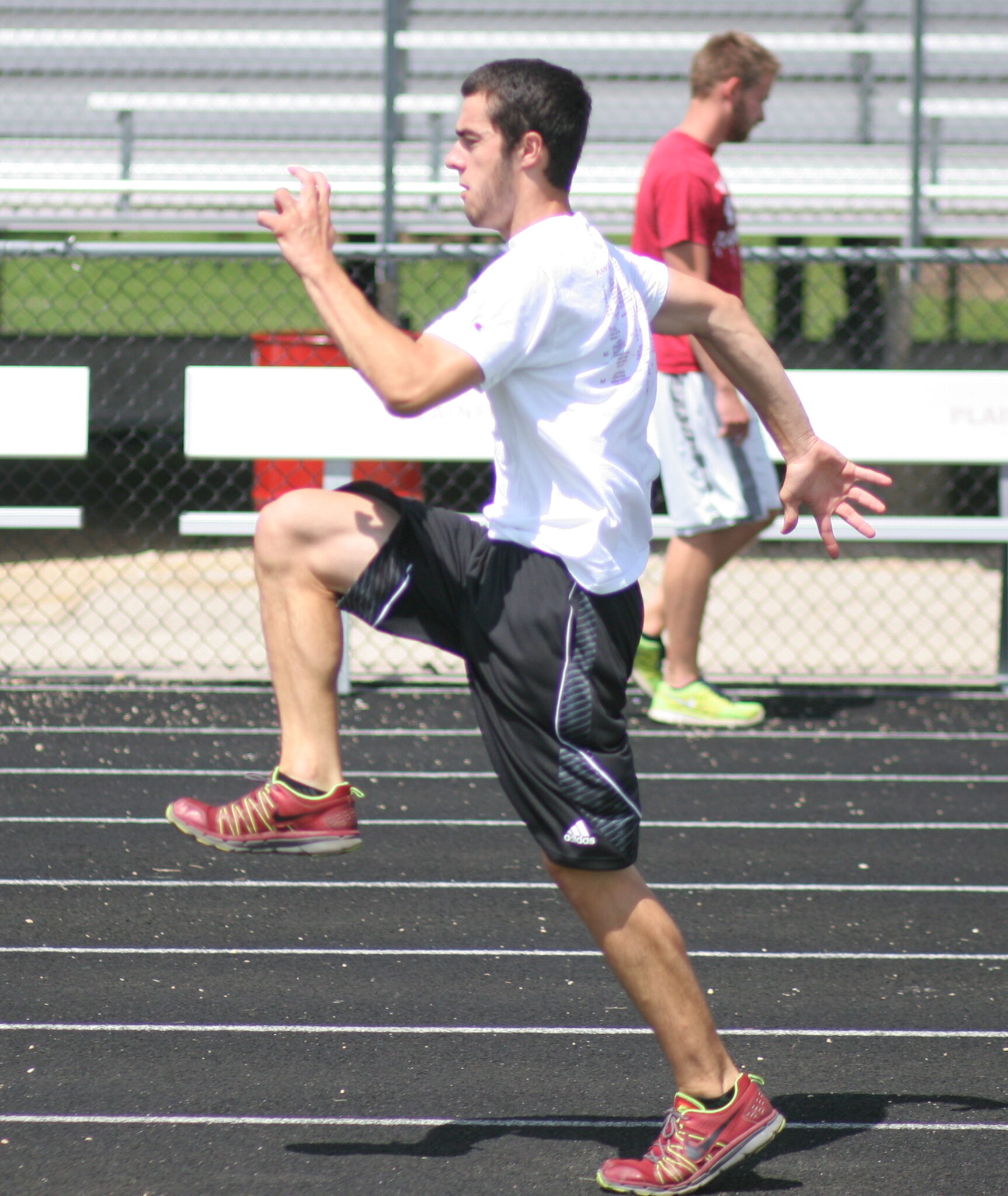
Sprinting and jumping are like electricity and magnetism. One creates the other. Sprinting improves jumping, jumping improves sprinting. (For those of you who are not scientists … electricity can make a magnet and a magnet can make electricity).
I train “bounce” with plyometrics. I’ve always defined plyometrics as “landing and jumping at the same time” … bounce. Remember, a sprinter bounces off the track. Ground contact times need to be almost non-existent. (as a song starts playing in my head … “Snap back to reality, Oh there goes gravity.” -Eminem)
We do low volume, high intensity plyometrics year-round.
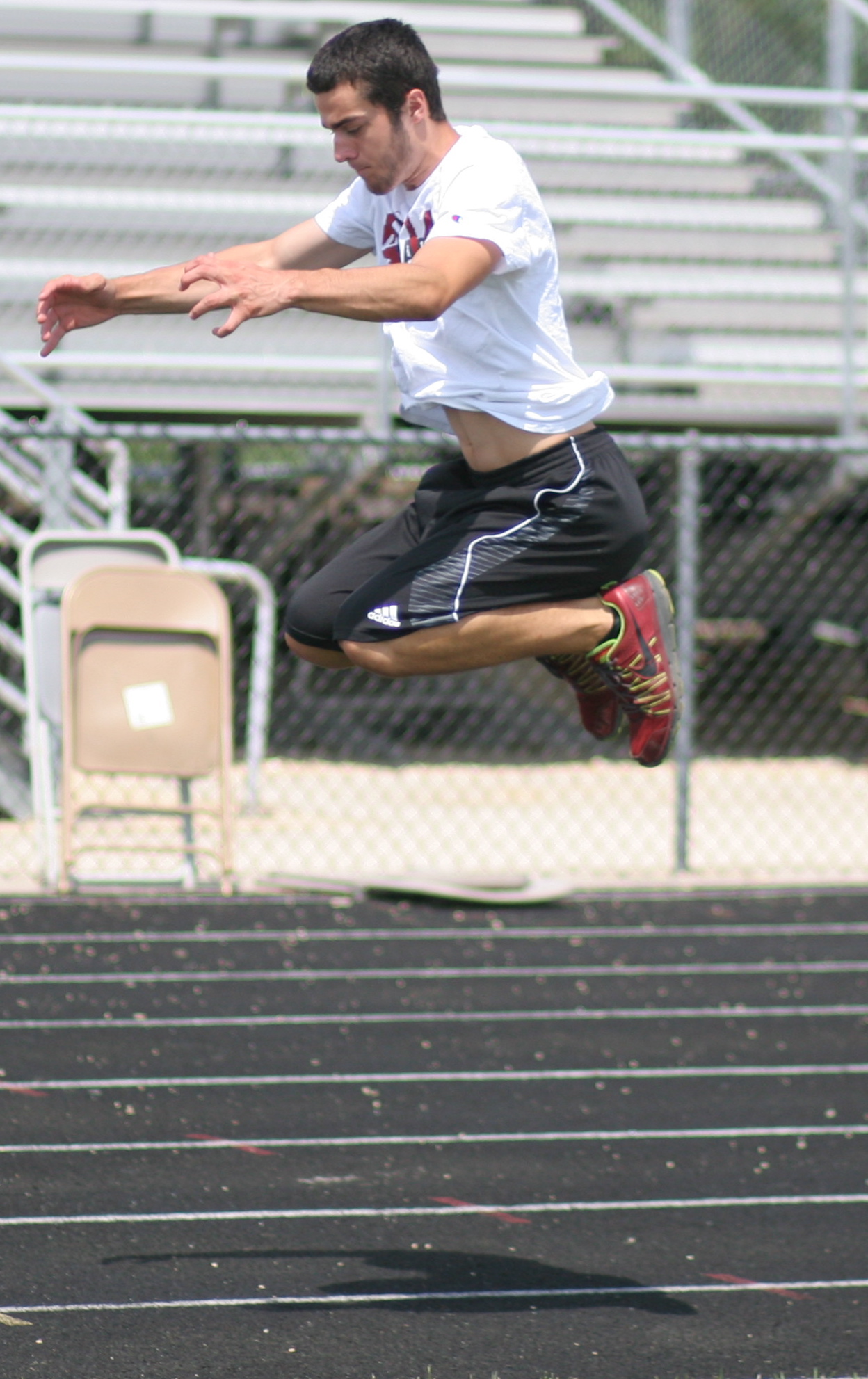
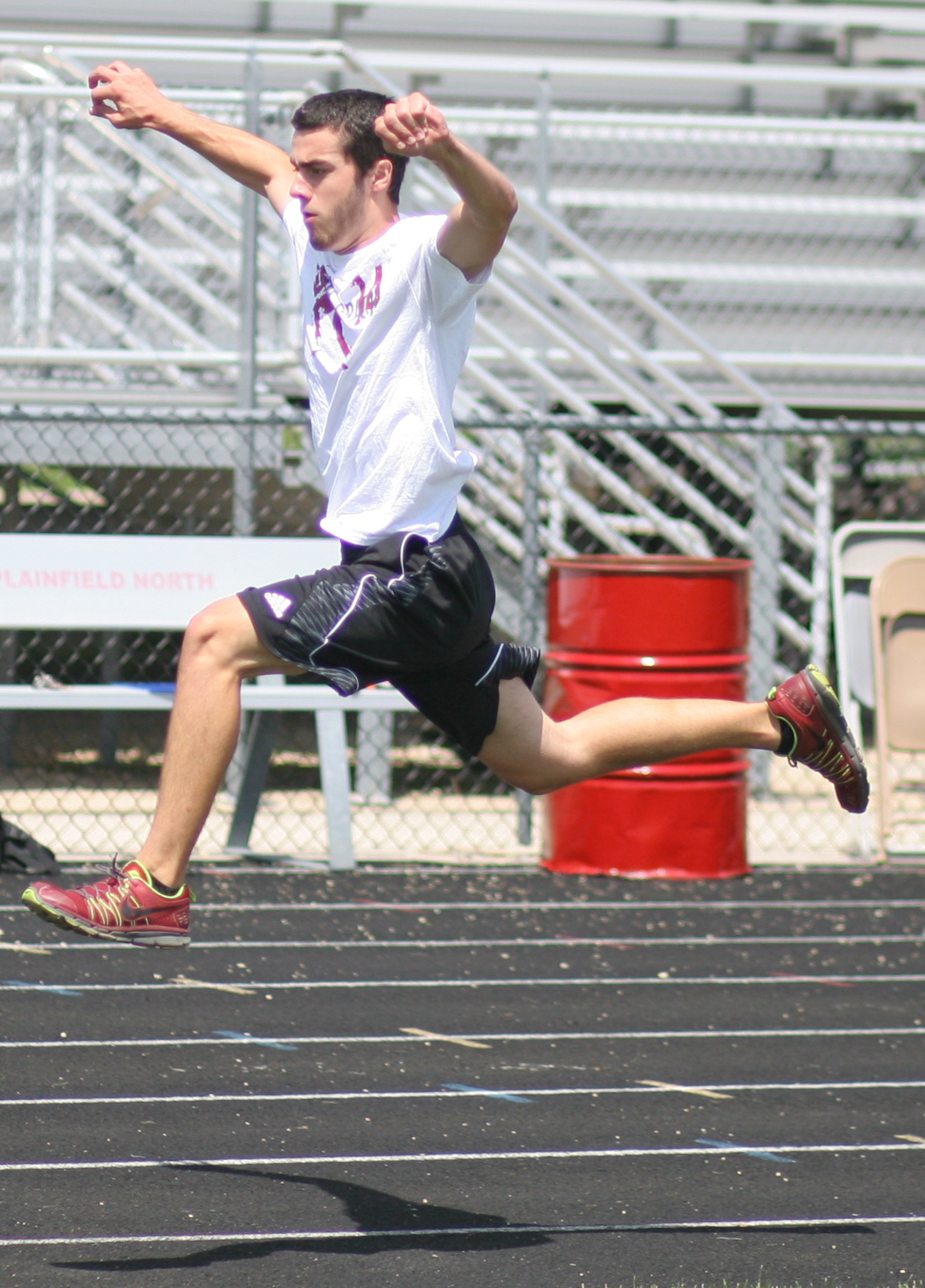

Record, Rank, and Publish
“If want to improve something, you begin by measuring it.” –Freelap USA Then you record it, rank it, and publish it. I’ve done this for a long time. My family makes fun of me for being a “Microsoft Excel Savant”. I also use spreadsheets on Google Docs. Back in 1998, I published rankings on a bulletin board in the main hallway of our high school. Now I publish to seven billion people on the internet.
I teach Honors Chemistry five times a day. When I simplify scientific method, I just tell my students that scientists measure things perfectly, then write it all down. That’s what I do as a sprint coach. I measure speed and write it down. Then I take advantage of the ultra-competitive testosterone-ridden personalities of high school boys by ranking their times, publishing their times, and celebrating improvement.
Sprinters will not truly sprint unless they are being timed. Quantified speed is the key to sprint training.
We have over 100 boys at Plainfield North who may not know their GPA but they definitely know their 40-time and their 10-meter fly time. #SpeedKills
Let’s study the speed numbers of Alex Ruscitti. Alex is the white guy shown in the pictures above.
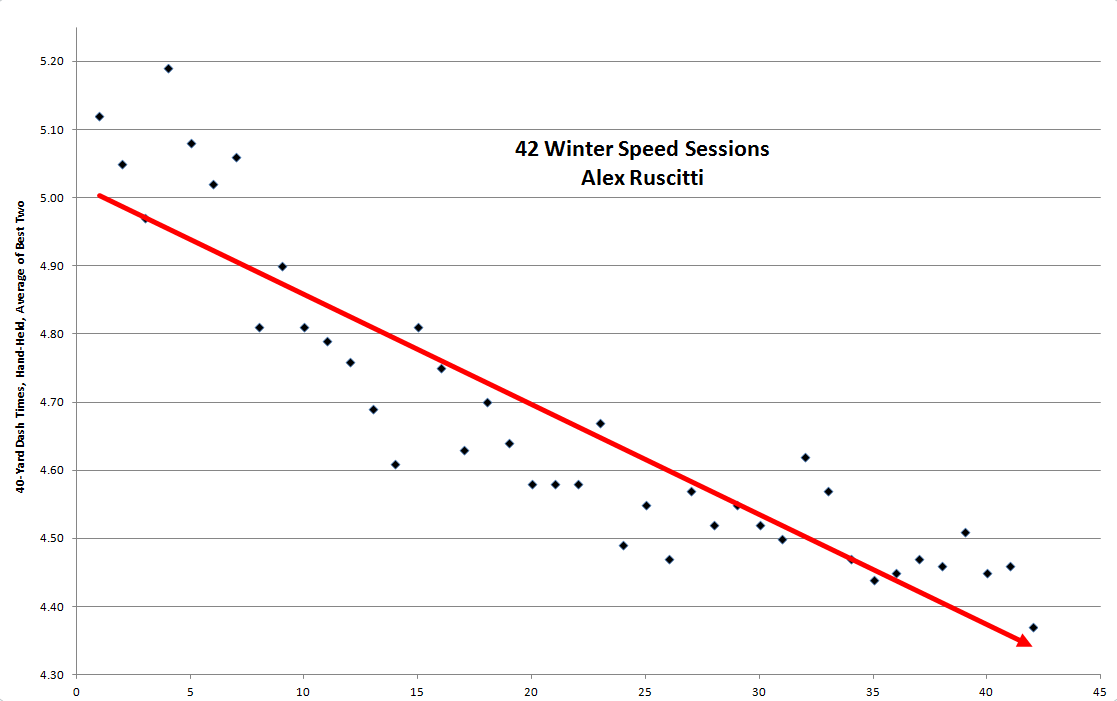
Improvement excites the athlete. Alex Ruscitti was the 6th fastest guy at Plainfield North last year. However, when Alex sees his measured progress, he can visualize what could happen his senior year.
Let’s look at all his trends …
- Speed Camp 40-yard dash, best time: 5.38 –> 5.09 –> 4.80 –> 4.70 –> 4.46
- Average 40-yard dash, winter training, Fr-Soph-Jr: 4.92 –> 4.61 –> 4.48
- Average 10-meter fly time, winter training, Fr-Soph-Jr: 1.18 –> 1.10 –> 1.08
- Best 4×1 relay time, Fr-Soph-Jr: 46.14 –> 44.06 –> 42.22
- Best 4×2 relay time, Fr-Soph-Jr: 1:35.14 –> 1:31.75 –> 1:28.61
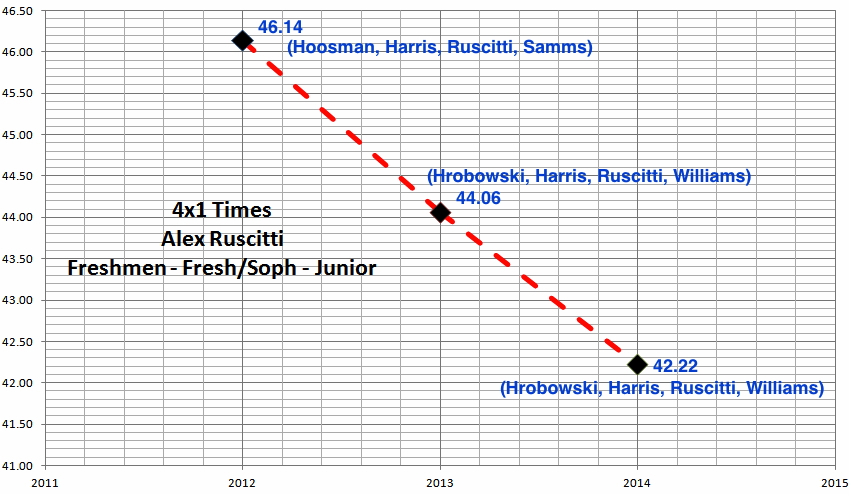
More data:

Consistency
I rant against coaches who enslave their athletes 12 months per year. I hate off-season traveling teams and AAU. When adults encourage kids to specialize, I want to throw up. Youth sports were never meant to be scholarship factories. If I could be king, I would eliminate NCAA athletic scholarships and cap the pay of college coaches. Coaches are teachers, not celebrities. Money made in athletics should be used to lower tuition. Scholarships should be given to future engineers who have financial need. God, I hate college sports. (But I can’t wait for college football season … I’m such a hypocrite.)
Having said that, I expect my sprinters to train every day year-round. Just kidding. Sprint training should never happen more than three or four days per week. Sprinters need to play multiple sports.
I offer a two-week Speed Camp in early June. It is coed with 10 year olds training next to Big Ten football players. Some of my sprinters come, some don’t. I encourage all my sprinters to play football. I think football forces kids to get tougher, more manly. (Is that politically correct?) Those who play football don’t think about track from June to November, and that’s a good thing.
However … incoming freshmen football players speed train three days a week in the summer, because I’m the head freshmen football coach. By the way, we’ve won 21 consecutive games. See Speed Kills.
From November to February my sprinters train four days per week. They train on the track and in the weight room. I have a reciprocal relationship with our head football coach. Perfect. The football program runs the weight room, the track program runs the sprint training. Our kids love it. On the track we NEVER do anything for more than 5 seconds at a time. We train at full speed and measure everything.
Winter speed training transitions into our indoor track season. After a much-needed spring break, we transition into our outdoor season. My sprinters have an opportunity to train nine months a year, year after year after year. Consistency.
Most of my sprinters train at least half the year, but consistency means much more than that. We SPRINT every time we train. We measure speed as a part of our training program. Quantification is not just diagnostic … it is motivational. Alex Ruscitti has been given a steady dose of encouragement based on his improving speed measurements.
Periodization is bullsh*t … we sprint always. We don’t have “general fitness” phases. We don’t ever do aerobic training. I guess, in a way we do have “periodization” … football, winter training, indoor season, and outdoor season. Those are our four “periods”. BUT WE NEVER RUN SLOW.
My program values rest and growth with the same enthusiasm as we value training. Coaches who grind kids do not allow time for growth.
My program values enthusiasm and love of sprinting more than all other things. I believe in lighting a fire, not filling a pail (from the William Butler Yeats quote). If I was an English teacher, I would have my kids read what they love, not what is assigned. Reading Stephen King with enthusiasm is better than trudging through Dickens with a bad attitude. By the way, Common Core sucks and Arne Duncan should resign and Barack Obama needs to reassess all he believes about education. Sorry for the rant. I believe in enthusiastic students and enthusiastic athletes.
Speed grows like a tree … so plant early and train often.
“Nothing in the world can take the place of persistence. Talent will not; nothing is more common than unsuccessful men with talent. Genius will not; unrewarded genius is almost a proverb. Education will not; the world is full of educated derelicts. Persistence and determination alone are omnipotent.” – Calvin Coolidge
“Eighty percent of success is showing up.” -Woody Allen
Teach mechanics, train at top speed, stick with it, and light a fire.
The word “speed” comes from the Dutch word “spoed”, the German word “spowan”, and the Old English word “spedan”. All three origins mean the same things … prosper & succeed, … go with speed.
Maybe it’s alright to be addicted to speed.
Godspeed to all, thanks for reading.
Since you’re here…
…we have a small favor to ask. More people are reading SimpliFaster than ever, and each week we bring you compelling content from coaches, sport scientists, and physiotherapists who are devoted to building better athletes. Please take a moment to share the articles on social media, engage the authors with questions and comments below, and link to articles when appropriate if you have a blog or participate on forums of related topics. — SF
[mashshare]




